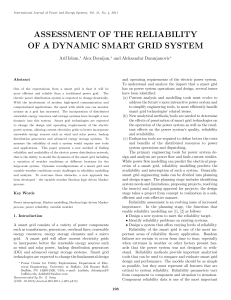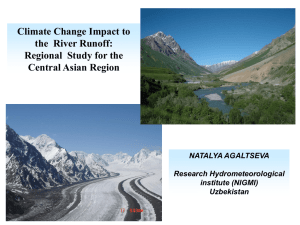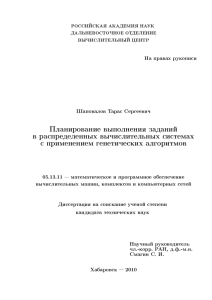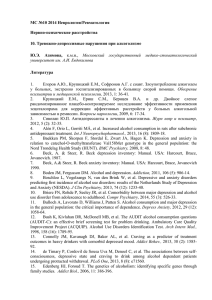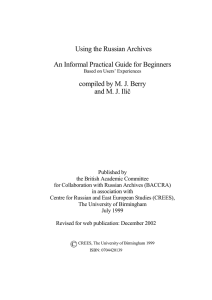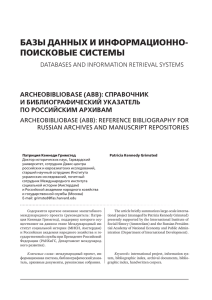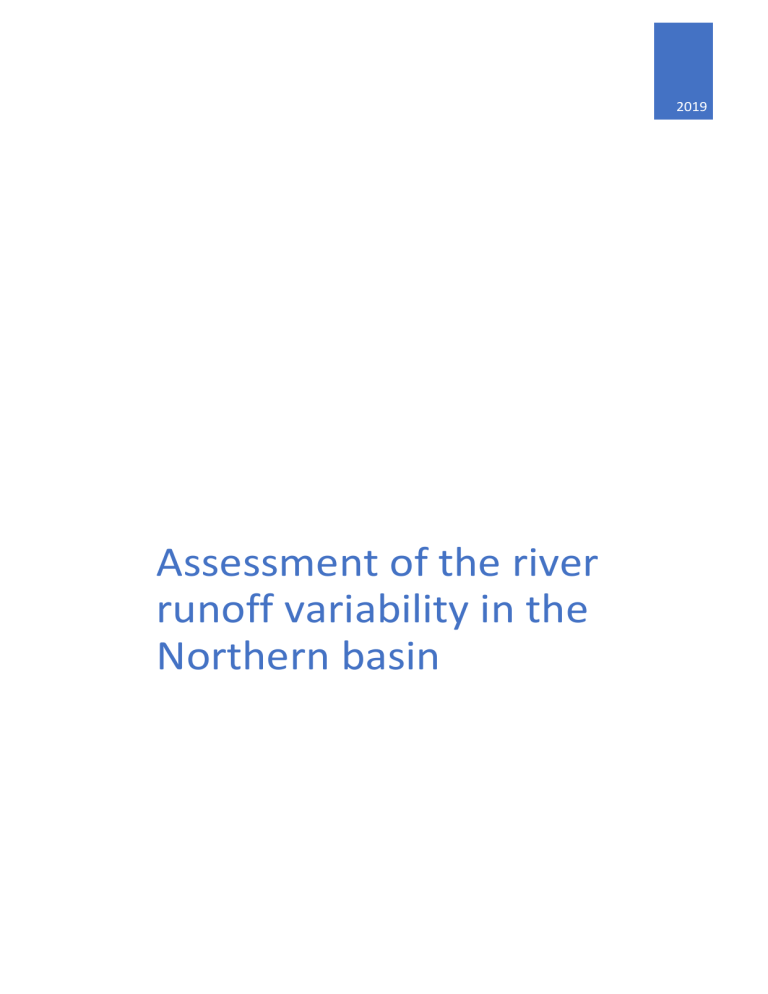
2019 Assessment of the river runoff variability in the Northern basin Introduction River runoff is an important climate variable because it is directly related to the water balance of the land and controls a wide range of climatological and environmental processes. This work is devoted to determining accuracy in grid data files, identify the required dependencies and forecasts changes in surface runoff. The relevance of the work lies in the fact that, despite its scientific and social significance, today there are no available estimates of runoff in the European North of Russia , the study of the state of the atmosphere aims to establish objective patterns that reflect the physical phenomena occurring in the Earth’s atmosphere. In this case, the goal of the work was to assess the accuracy of the hydrometeorological data archives and to predict their effect on the runoff. For this, the following tasks were solved: 1. 2. 3. 4. 5. 6. Study of literature on a given topic Research Object Selection Identify required grid archives Evaluation of the accuracy of the meteorological archive E - OBS Calculation of the influence of climatic characteristics on runoff Runoff change forecast The object of the study was the North Dvina basin. This territory has been well studied, for it there is the necessary data for comparison, both observable and grid. In addition, in such a territory it is possible to check the exposure to the zoning of grid archives. Methods Existing grid archives have a complex structure, which is characterized by 3 types of information: 1. Interpolation 2. Reanalysis Methods 3. Satellite data Firstly, any system should rely on “hard” data - that is, accurately, independent measurements on weather sites, gauging stations, etc. For these purposes, different developers use different data arrays. Secondly, through complex mathematical transformations, interpolations, uniform data arrays are obtained, which will be distributed throughout the research area. At this stage, kriging is widely used because of its peculiarity to smooth out peaks, but to reveal characteristic features, also spline surface methods and others. Thirdly, satellite data is used for the final verification, which allows you to adjust the mathematical model, allowing you to more accurately evaluate hydrometeorological values. The use of remote sensing methods in hydrometeorological surveys lasts for a rather short period of time. The range of possibilities of these types of studies is certainly high. Remote sensing - a process or method of obtaining information about an object, site or phenomenon by analyzing data collected without contact with the studied object. (Chandra , A.M., 2008). Such methods can be used to obtain information about an object or phenomenon without direct physical contact with this object. The results of environmental sounding are widely used, primarily in the preparation of numerical weather forecasts, as well as in the study of phenomena and processes occurring in the atmosphere. The role of information obtained in the process of sounding the atmosphere and in satisfying the needs of many sectors of the country's economy is great. The development of environmental sounding methods and the study of processes occurring in the atmosphere are one of the important conditions for the success of almost all areas of modern meteorology. Comparing remote data with ground data, it is necessary to talk about the advantages and disadvantages of those and other research methods. In a general sense, ground-based observations. They make up most of the information operated by today's scientific community, it is worth adding that, according to data from 50 years ago, serious research is still being conducted in the field of hydrometeorological surveys. There are several objective reasons for this. Firstly, in Soviet times, a powerful apparatus for observing the hydrometeorological situation was organized in our country, which made it possible to observe air temperature, humidity, evaporation, river flow, and other characteristics almost everywhere. Secondly, these data were long-term, many monthly series of observations are more than 50 years, which can be used in statistical forecasts. Thirdly, the observations were strictly formalized and, if available, could be used for scientific purposes. Speaking about the shortcomings of ground data, it is worth mentioning first, their uneven distribution over the territory of the country. If the coverage for Europe can be considered satisfactory, then for the Asian part and the territory of the north, the data density is significantly reduced. The next problem is the irregularity at the present time, if the situation was regularly observed even in remote stations under the USSR, now it is extremely difficult to find new weather data. Thirdly, it is their high cost, in order to maintain observations at meteorological and hydrological posts, it is necessary to maintain personnel, not to mention expeditionary data. Thus, we logically conclude that for observations now we just do not have enough ground data, therefore statistical methods, namely grid data archives, have become widespread. This article discusses several products, one of which is E-OBS. The ECA Dataset (E-OBS ) contains a series of daily observations at weather stations throughout Europe and the Mediterranean. Part of the data set is available for nonprofit research and education. The goal of ECA & D is to combine daily series of observations at meteorological stations, quality control, extreme analysis and dissemination of both daily data and analysis results. A series collected from participating countries, as a rule, does not contain data for recent years. This is partly due to the time it takes to control the quality of the data and archiving of participants' home institutions, and partly to the result of the efforts needed to include the data in the ECA database. Data files contain grid data for 5 elements (daily average temperature TG, daily minimum temperature TN, daily maximum temperature TX, daily total precipitation RR and daily average sea level pressure PP). They cover an area: 25 n.h.-75n.h. x 40 w.h.-75 e.h. Data files are in compressed NetCDF format. There are 4 different versions: 2 mesh resolutions x 2 mesh shades. Data is available on a 0.25and 0.5-degree grid on a regular grid. For climate analyzes, arrays of spatial meteorological observations interpolated into a regular grid are important. Such gridded datasets have been widely used in the past and are still important for many reasons. Firstly, such interpolated data sets allow one to obtain the best estimates of climatic variables in places remote from observation stations, which allows local climate studies in regions with limited data. Second, average area indices are often used to monitor climate change on a regional and wider scale. Such indicators vary widely, from those that represent local regions, such as the temperature in Central England to the indices of global changes, such as average global temperature. Thirdly, studies of climate variability often need regional models of dependent variability and therefore use multidimensional methods such as principal component analysis, correlation analysis, and singular value decomposition. Such methods prefer regular interval observations so as not to shift eigenvalues in the region with a higher density of observations. Fourth, the process of validating regional climate models (RCMs) is becoming increasingly important as such models are becoming increasingly popular for regional studies of climate change. Such a direct comparison between models and interpolated data suggests that the observations and the model point to processes on the same spatial scale. Therefore, the construction of a grid data set, where each grid value is the average value of the estimate of the squares of the grid, is the most suitable data set to confirm the model, and not a direct comparison between model and point observations. Finally, impact models are important in determining the possible effects of climate change, such as crop yields. Such models often require regular intervals between data and are much easier to implement using time-constant intervals. To assess the accuracy of the grid data, E-OBS data were selected from the entire variety of grid products, the first of which is meteorological processing data, the second is river flow. Both products are distributed free of charge for non-commercial purposes. The first stage was the search for meteorological products that should follow parameters: 1. Data lasting at least 30 years 2. These are common in the north of the European oh frequently and Russia 3. Updatable data was to be - every day Results As a result, the following tasks are currently solved: determining the necessary grid archives, programming scripts for importing data, evaluating the accuracy of the E-OBS meteorological archive. Having solved the tasks, the following results were obtained: 1. Graphing the dependence of the grid data E - OBS and instrumental with the trend equation for each post 2. Checking the zoning of the error distribution as a factor in influencing the quality of measurements 3. Identification of the dependence of the absolute error on the averaging interval 4. Checking the effect of water availability and basin area on the quality of grid data The results were evaluated at different averaging intervals. For meteorological data, 4 intervals were chosen: monthly, seasonal, annual, long-term; for hydrological data, everything except seasonal. The error distributions were obtained over the averaging interval, for meteorological data from 2% of the long-term period to 27% of the monthly, for hydrological data from 12% of the long-term period to 70% of the monthly. In general, we can say that the error for meteorological archives is lower than for hydrological ones, it grows more slowly, but the nature of the dependence is similar, in both cases there is an inverse relationship between the averaging interval and the absolute error. To identify the zoning of the distribution of errors in the territory under consideration, maps were compiled, but zoning was not identified. According to similar studies, the measurement error is confirmed by zoning indirectly, since most often the density of the measuring posts falls from south to north, but in this study, we took a homogeneous territory in terms of density, therefore, such errors can be eliminated The dependence of the river water content on the measurement error was revealed; for more highwater rivers, a decrease in the error in the grid data is characteristic. The reason for this conclusion is that the grid interpolators are much better at handling large vibration amplitudes than the small ones that are characteristic of large rivers. Checking the dependence of the measurement error on the catchment area showed an inhomogeneous distribution, which means that there is no dependence between the data. References 1. YU. G. MOTOVILOV & A. N. GELFAN Assessing runoff sensitivity to climate change in the Arctic basin: empirical and modelling approaches, Cold and Mountain Region Hydrological Systems Under Climate Change: Towards Improved Projections Proceedings of H02, IAHSIAPSO-IASPEI Assembly, Gothenburg, Sweden, July 2013 (IAHS Publ. 360, 2013). 2. Gelfan A.N. 1, Motovilov Yu.G. 1, Kalugin A.S. 1, Krylenko I.N. 1,2, Lavrenov A.A.1, Merkulov N.A.3 ANALYSIS OF SENSITIVITY OF THE MAXIMUM RIVER STOCK TO CHANGE THE CLIMATE CONDITIONS OF ITS FORMATION 3. Zolina, O., C. Simmer, K. P. Belyaev, A. Kapala, S. K. Gulev. Improving estimates of heavy and extreme precipitation using daily records from European rain gauges.// J. Hydrometorol., 2009, 10, 701-716. 4. Groisman, P. Y., Knight, R. W., & Karl, T.R. Changes in Intense Precipitation over the Central United States// Journal of Hydrometeorology, 2012. 13(1), 47-66 5. Stocker T.F et al. Technical Summary. In: Climate Change 2013: The Physical Science Basis. Contribution of Working Group I to the Fifth Assessment Report of the Intergovernmental Panel on Climate Change [Stocker, T.F. et al (eds.)]. Cambridge University Press, Cambridge, United Kingdom and New York, NY, USA. 6. NRC (2011) Global Change and Extreme Hydrology: Testing Conventional Wisdom. The National Academies Press, Washington, D.C. 7. Kuchment L.S., Motovilov Yu.G. , Nazarov N.A. The sensitivity of hydrological systems. - M .: Nauka, 1990. –144 p. 8. Razavi, S., H. V. Gupta. What do we mean by sensitivity analysis? The need for comprehensive characterization of ‘‘global’’ sensitivity in Earth and Environmental systems models // Water Resour. Res., 2015, 51. doi:10.1002/2014WR016527. 9. Song X., Zhang J., Zhan C., Xuan Y., Ye M., Xu C. Global sensitivity analysis in hydrological modeling: Review of concepts, methods, theoretical framework, and applications/ // J. Hydrology, 2015. 523, 739-757. 10. Motovilov Yu. G., Gottschalk L, Engeland K., Belokurov A. ECOMAG: Regional model of hydrological cycle. Application to the NOPEX region. Department of Geophysics, University of Oslo, Institute Report Series No: 105. 1999, ISBN 82-91885-04-4. 88p.
